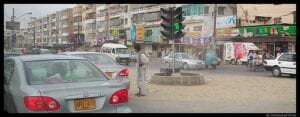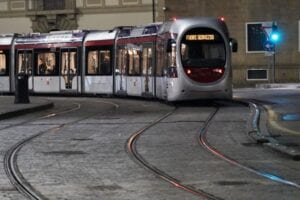What wayfinding meant for me?
Wayfinding, a term unknown to me only 4 weeks earlier, has been a topic for my attention and the victim of my critical thinking and analysis lately. I grew up in Pakistan until I was 9 years old, where the definition of Wayfinding revolved around asking strangers on the street for guidance to the addresses, as there were no proper signages, and those that did exist had been outdated. The landmarks pertained to the very old shops or stores, such as the way I gave the address of my house to a friend by saying “Have you seen Disco Mor*? Yes the one where Rickshaw stands are. Enter the street which has ‘Imran Paan* Shop’ on the corner of it and it’s the second bungalow”.
 A picture of Disco Mor with a Rickshaw standing in front of Imran Paan shop.
A picture of Disco Mor with a Rickshaw standing in front of Imran Paan shop.
I would have never realized that wayfinding is a topic of study as well as a profession. Living in the UAE in the past 10 years, I am still not sure over the routes I am allowed to take while driving. Did I ever think any of these were badly designed? No, not once. Similarly, not being able to find the A5 building, on the campus signage during Marhaba was only a consequence of my lack of sense of direction. Or so I thought. In fact, I would marvel at the architecture of our campus and how beautifully it has been designed – only before it became a victim to my critics in the past 4 weeks. Even in instances of architecture appreciated by the world, an example being Dubai Mall, I could never find my way in spite of having visited it multiple times and having asked the help desk personnel for directions. However, it is only now that I understand that the flaw wasn’t in me, it has in fact been in the design. What seems aesthetically pleasing can not be automatically regarded as being ‘well designed’.
What exactly is wayfinding?
The concept of design does take into consideration the visual aspects, since we are ultimately ‘visual mammals’, however the ability for it to be navigated easily and conveniently, taking into account the differently abled individuals, is what concatenates the idea of a good design.
Looking back at an example discussed in the class where an individual used a font of their choice, Comic Sans, for writing articles. I would not have regarded it as a problem until I was made to realize that what seems ‘cool’ or ‘pleasing’ to yourself may not be acceptable or really the standard. There are some principles that are essential and have to be followed for implementing any design. It is these principles that associate an identity to the wayfinding systems and from what I would consider a subconscious response to these systems with their consistency. Looking for Exit 11 on the highway? A small sign with blue background and text in the sans serif font will be the lookout!
Even though I have spent two years living at the NYU Abu Dhabi campus, it is only now that I realize the design inconsistency in the various aspects. In a walk around the campus, Professor Goffredo highlighted the inaccessible design, particularly referring to the braille signage around campus. In contrast to most places that lack the accessibility aspect, I had always thought our campus was very inclusive, only impressed by the braille imprints on some signages. However, when you actually think from the perspective of a person with visual impairment, you realize the significance of consistency in design – a particular example being the braille prints over the buttons outside the lift, and then being next to the button instead of being on top of them again.
Being made aware of these very small aspects that sum up a good design, I have since been observing the smallest of things in regards to design and signage. An instance, which I may not have noticed earlier, was when I saw a visually impaired person calling the ‘Public Lift 2’ on campus. I noticed that they were aware of the placement of the buttons and were aware of the design inconsistency, having spent some time on campus. However, what alarmed me was when the lift arrived, they could not easily identify with the ‘ting’ sound of the lift as to which of the two lifts had arrived. It made me realize that the problem lied far beyond only the inconsistency of design.
Is wayfinding really even needed?
Some people question whether in the busy hurried and digital lives that we live, do we still even need wayfinding? Who even has the time to read and understand complicated maps when you can just ask around where a specific building is located? But that is exactly the point! Good wayshowing would not consume so much time to understand the maps. Maps are in place to simplify the experience of wayfinding, not to complicate it and frustrate the user. If a map is too confusing to understand or takes too long to read, it’s not a good means of wayshowing in the first place.
Though in this modern digital world, GPS and WiFi systems have definitely simplified the experience of finding routes, wayfinding design is still crucial. A satellite map cannot tell me how to navigate to the American Eagle store on the 3rd Floor. Even if it can, it requires some prerequisite resources. If we solely start to rely on the GPS systems, how would we navigate in the absence of WiFi connection, or if the phone battery dies or if Google Maps has not even been updated with the latest routes?
An example of such an instance was when my phone battery died on the top of Piazzale Michelangelo in Florence and I had to navigate my way back home. With no idea what times the buses will be arriving and which combination of buses will take me to my destination, I hopped on a random bus which actually took me to the outskirts of Florence. This was the first time I was truly grateful that ‘Compassing’ was only one of 9 strategies for wayfinding. Like Hansel and Gretel, I resorted to the most basic and effective one: Track Following. After asking some shopkeepers on how to get back and continuously losing my way, I was advised to simply follow the tram lines which led me directly to my destination.
 A picture of the tram lines in Florence.
A picture of the tram lines in Florence.
Incidents like these are when we truly appreciate the importance of good wayfinding design. Different environments create different problems as well as provide different solutions. However, the 6 principles of good wayfinding design systems are constant and as follows:
-
-
- Perceptible by all necessary senses.
- Available at any user’s level of ability.
- Usable without enduring a safety hazard.
- Accessible without making significant effort.
- Obtainable in its simplest form.
- Variable in its use of media.
-
All in all, from not even considering wayfinding as having any relation with graphic design, I have come to a point where I actually regard wayfinding as a system of design. Anywhere I go, I view the design elements with an entirely new and considerate perspective, where something that is only aesthetically pleasing does not satisfy me, unless it is actually easily accessible and convenient for all visitors.